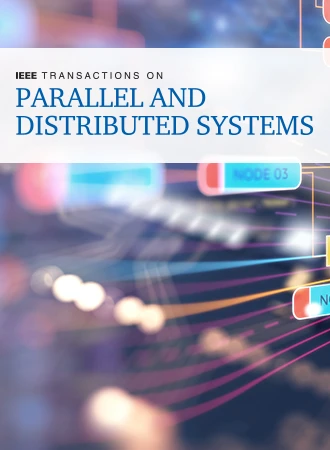Featherlight Stateful WebAssembly for Serverless Inference Workflows
IF 5.6
2区 计算机科学
Q1 COMPUTER SCIENCE, THEORY & METHODS
IEEE Transactions on Parallel and Distributed Systems
Pub Date : 2025-06-02
DOI:10.1109/TPDS.2025.3575753
引用次数: 0
Abstract
In serverless inference, complex prediction tasks are executed as workflows, relying on efficient state transfer across multiple functions. Serverless platforms typically deploy each function in a separate stateless container, depending on external processes for state management, which often results in suboptimal system utilization and increased latency. We introduce WasmFlow, a novel framework designed for serverless inference that ensures low latency and high throughput. This is achieved through process-level virtualization using WebAssembly. WasmFlow operates functions on a per-thread basis within compact WebAssembly modules, significantly reducing startup times and memory usage. The framework has two key features. (1) Efficient Memory Sharing: WasmFlow facilitates direct and rapid state transfer between functions using threads within the WebAssembly runtime. This is enabled through lightweight, lock-free, zero-copy intra-process communication, complemented by effective inter-process RPC. (2) System Optimizations: We further optimize WasmFlow with an advanced synchronization technique between functions, an affinity-aware workflow scheduler, and adaptive request batching. Implemented and integrated within the Kubernetes ecosystem, WasmFlow’s performance was evaluated using synthetic workloads and real-world Azure traces, including typical serverless workflows and ML models. Our results demonstrate that WasmFlow dramatically outperforms existing serverless frameworks. It reduces P90 end-to-end latency by 74x and 78x, increases function density by 1.7x and 223x compared to Faasm and SPRIGHT, and improves system throughput by 12.3x and 8.8x over Knative and WasmEdge, respectively.用于无服务器推理工作流的轻量级有状态WebAssembly
在无服务器推理中,复杂的预测任务作为工作流执行,依赖于跨多个功能的有效状态传输。无服务器平台通常将每个功能部署在单独的无状态容器中,这取决于状态管理的外部进程,这通常会导致次优系统利用率和延迟增加。我们介绍WasmFlow,这是一个为无服务器推理设计的新框架,可确保低延迟和高吞吐量。这是通过使用WebAssembly的流程级虚拟化实现的。WasmFlow在紧凑的WebAssembly模块中以每个线程为基础操作函数,显著减少了启动时间和内存使用。该框架有两个关键特性。(1)高效的内存共享:WasmFlow在WebAssembly运行时中使用线程促进函数之间直接和快速的状态传输。这是通过轻量级、无锁、零复制的进程内通信以及有效的进程间RPC来实现的。(2)系统优化:我们进一步优化了WasmFlow与功能之间的先进同步技术,亲和感知工作流调度程序和自适应请求批处理。在Kubernetes生态系统中实现和集成的WasmFlow的性能使用合成工作负载和真实的Azure跟踪进行评估,包括典型的无服务器工作流和ML模型。我们的结果表明,WasmFlow显著优于现有的无服务器框架。与Faasm和SPRIGHT相比,它将P90端到端延迟分别降低了74倍和78倍,将功能密度分别提高了1.7倍和223倍,并将系统吞吐量分别提高了12.3倍和8.8倍。
本文章由计算机程序翻译,如有差异,请以英文原文为准。
求助全文
约1分钟内获得全文
求助全文
来源期刊

IEEE Transactions on Parallel and Distributed Systems
工程技术-工程:电子与电气
CiteScore
11.00
自引率
9.40%
发文量
281
审稿时长
5.6 months
期刊介绍:
IEEE Transactions on Parallel and Distributed Systems (TPDS) is published monthly. It publishes a range of papers, comments on previously published papers, and survey articles that deal with the parallel and distributed systems research areas of current importance to our readers. Particular areas of interest include, but are not limited to:
a) Parallel and distributed algorithms, focusing on topics such as: models of computation; numerical, combinatorial, and data-intensive parallel algorithms, scalability of algorithms and data structures for parallel and distributed systems, communication and synchronization protocols, network algorithms, scheduling, and load balancing.
b) Applications of parallel and distributed computing, including computational and data-enabled science and engineering, big data applications, parallel crowd sourcing, large-scale social network analysis, management of big data, cloud and grid computing, scientific and biomedical applications, mobile computing, and cyber-physical systems.
c) Parallel and distributed architectures, including architectures for instruction-level and thread-level parallelism; design, analysis, implementation, fault resilience and performance measurements of multiple-processor systems; multicore processors, heterogeneous many-core systems; petascale and exascale systems designs; novel big data architectures; special purpose architectures, including graphics processors, signal processors, network processors, media accelerators, and other special purpose processors and accelerators; impact of technology on architecture; network and interconnect architectures; parallel I/O and storage systems; architecture of the memory hierarchy; power-efficient and green computing architectures; dependable architectures; and performance modeling and evaluation.
d) Parallel and distributed software, including parallel and multicore programming languages and compilers, runtime systems, operating systems, Internet computing and web services, resource management including green computing, middleware for grids, clouds, and data centers, libraries, performance modeling and evaluation, parallel programming paradigms, and programming environments and tools.
 求助内容:
求助内容: 应助结果提醒方式:
应助结果提醒方式:


